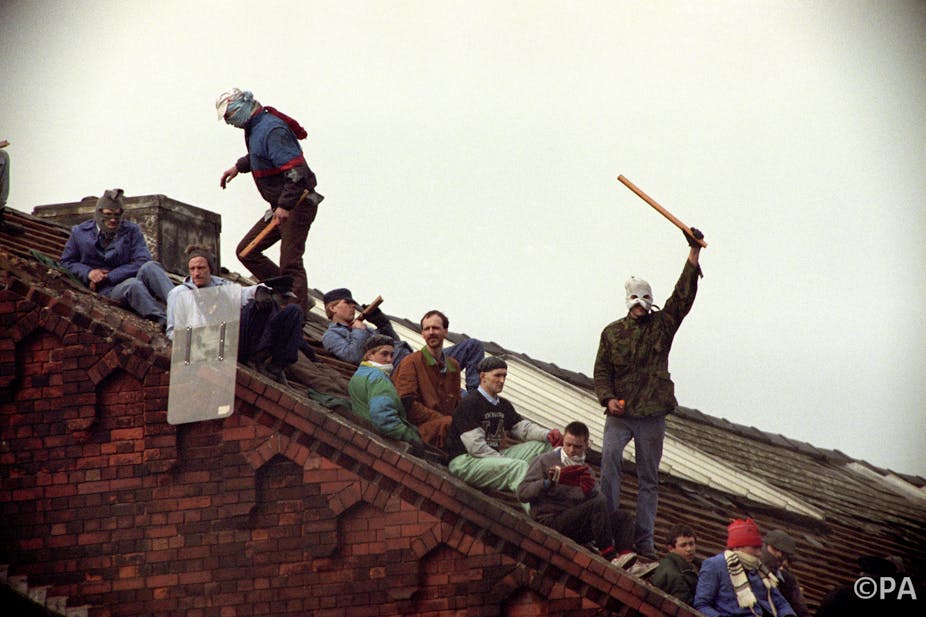Strangeways high-security prison opened in 1868. A classic of Victorian prison design, its iconic watchtower remains a distinctive feature of the Manchester skyline, a brooding brick presence at odds with the chrome and steel that now dominates.
But Strangeways is best known as the scene of the longest prison riot in British history. It unfolded as prisoners rebelled against the poor conditions at the prison and was supposed to have changed the face of the penal system forever. But as we mark the 25th anniversary of the siege, it feels as though British prisons have scarcely improved.
It has been pointed out that prisons are oddly familiar to most people but few have any real knowledge of they are really like or how they function. The way prisons are portrayed in the media therefore has a very important influence on debates about penal policy.
In 1980, the BBC aired a fly-on-the-wall documentary series filmed at Strangeways by the legendary filmmaker Rex Bloomstein.
It revealed the overcrowding that left prisoners living three to a cell and showed that there were limited, if any, constructive activities on offer. Viewers also saw that the practice of slopping out was still going on – there were no toilets in cells so prisoners had to use a bucket and empty it out every morning.
Three days before the 1990 riot, the Chief Inspector of Prisons had published a largely favourable report, outlining progress that had been made at Strangeways since the Fresh Start initiative of 1987. This was swept aside by the events of early April 1990.
The riot began at a service in the chapel on April 1. The original disturbance rapidly spread and soon the prisoners had taken over the prison. They rioted for 25 days.
Soon after the takeover began, prisoners started to appear on the roof. A number remained throughout the protest, creating a sideshow for the press and Manchester commuters. One prisoner greeted the locals and the media with a cry of “Good morning, Manchester”.

Within days, unrest had spread to 20 other prisons across the country.
The tabloid press reported that prisoners were being murdered and told lurid tales of kangaroo courts being set up to try prisoners on remand for sex offences. They said 20 people had died at Strangeways.
In the end, these claims turned out to be exaggerated. But two people had died – a guard and a prisoner. It also became clear that vulnerable prisoners had been subjected to appalling violence.
When the riot eventually ended, 23 of the prisoners were sentenced to a total of 140 years imprisonment. The iconic jail had been destroyed. The rebuild would ultimately cost more than £100 million.
The prison was renamed HMP Manchester after the riot but, the Strangeways name has remained in common usage.
The lesson learnt
In the aftermath of the riot, a public inquiry was established, headed by the liberal Lord Justice Harry Woolf. When the inquiry reported its findings in 1991, it called for fundamental changes to be made to the prison system.
These included the abolition of the indefensible system of slopping out by 1996 and improvements to prison discipline, including the establishment of a prison ombundsman to investigate prisoner grievances. Woolf also identified overcrowding as a key factor in the crisis in the prison system and called for smaller institutions.
In 1994, Conservative Michael Howard became home secretary and there was a significant shift in the penal system. Howard was committed to the notion that “prison works” and oversaw an expansion in the use of imprisonment.
When the Strangeways riot began, there were around 43,000 people in prison, there are now more than 85,000.
The lesson forgotten
There are growing concerns about the current conditions in prisons in England and Wales. The most recent report from the Chief Inspector of Prisons drew a bleak picture that had echoes of the system in 1990 prior to the Strangeways riot.
Suicides and bullying are still on the rise and drugs are easily available. Shortages are putting staff at risk and the number of assaults has risen.
One of the most important messages from the 1991 report was the corrosive impact of overcrowding. It is simply not possible to manage a system in a humane fashion when prisons are so full. As a society, we need to overcome our addiction to the use of imprisonment and recognise that we spend huge sums of money each year on propping up these failing institutions.
Ahead of the Strangeways anniversary, Woolf called for a new inquiry into prisons. He said conditions are as bad now as they were 25 years ago.
The penal system has not been a feature of the 2015 general election campaign so far and this is unlikely to change. Hopefully, it will not take another riot with such huge personal and economic costs to force us to examine the damage the current prison system is doing to our society.

